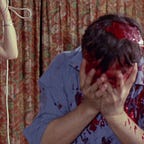Dementia on the 13th
Dementia is a film too often neglected in the history of cinema. It was written, produced, and directed by John Parker in 1953, and I'm certain that no American film of the time rivals it in its surrealist nature.
It's a completely silent film, told without any dialogue, the only sound being from the eerie score, punctuated by female falsetto vocals. It's one of few films made since the 1920s to opt for pure visual storytelling.
As you can imagine, there isn't much in the way of plot. A young woman is plagued with insomnia and finds herself wandering through the streets, getting picked up by one shady character after another, including a fat cat gangster played by Bruno Ve Sota. It's a film you not so much review as diagnose what it all represents.
The young woman, "The Gamin" as she's known, seems to be struggling with some form of social anxiety. We first see her sleeping alone in a hotel room, waking from a nightmare. She wanders outside her room and stumbles across an officer reporting to a scene of domestic violence, to which she hides away from in the stairwell, until the officer drags the offending husband away.
In the middle of the film, we are shown the gamin's past trauma, as she has a flashback to when she witnessed her father murder her mother, which then drove her to stab Daddy in the back. Later, we see the gamin chased by a cop portrayed by the same actor as her father. This could represent her guilt over murdering her father coming back to haunt her.
She gets mixed up in the seedy underworld of Los Angeles and finds solace and companionship with some corrupt types, probably because she grew up in a broken home and could never find love in polite society.
The film showcases some impressive cinematography, with tracking shots, pedestal shots, deep focus, and lots of shadows. Parker was clearly taking inspiration from the likes of Orson Welles (the Ve Sota character could easily be a stand-in for a Welles type) while also developing his own fresh style that evokes the feeling of a dream.
The film was completed in 1953, but was swiftly banned by the New York State Film Board for being "indecent" and "inhuman". It wouldn’t be released until two years later, after the censors demanded images of a severed hand be removed. These sequences have since been restored.
The film was then picked up by producer Jack H. Harris and Exploitation Productions (no joke) and re-released another two years later, under the title of Daughter of Horror, with added narration by Ed McMahon. This version can be seen being screened to a crowd of unsuspecting teenagers before they are attacked by The Blob.
